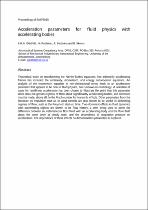JavaScript is disabled for your browser. Some features of this site may not work without it.
- ResearchSpace
- →
- Research Publications/Outputs
- →
- Conference Publications
- →
- View Item
| dc.contributor.author |
Gledhill, Irvy MA

|
|
| dc.contributor.author |
Roohani, H

|
|
| dc.contributor.author |
Biobaku, A

|
|
| dc.contributor.author |
Skews, B

|
|
| dc.date.accessioned | 2017-02-23T10:00:14Z | |
| dc.date.available | 2017-02-23T10:00:14Z | |
| dc.date.issued | 2016-06 | |
| dc.identifier.citation | Gledhill, I.M.A., Roohani, H., Biobaku, A. and Skews, B. 2016. Acceleration parameters for fluid physics with accelerating bodies. In: The Proceedings of The 60th Annual Conference of The South African Institute of Physics (SAIP2015), 29 June - 3 July 2015, Port Elizabeth, Boardwalk Convention Centre | en_US |
| dc.identifier.isbn | 78-0-620-70714-5 | |
| dc.identifier.uri | http://events.saip.org.za/getFile.py/access?resId=73&materialId=6&confId=53 | |
| dc.identifier.uri | http://hdl.handle.net/10204/8952 | |
| dc.description | The Proceedings of The 60th Annual Conference of The South African Institute of Physics (SAIP2015), 29 June - 3 July 2015, Port Elizabeth, Boardwalk Convention Centre | en_US |
| dc.description.abstract | Theoretical work on transforming the Navier-Stokes equations into arbitrarily accelerating frames has included the continuity, momentum, and energy conservation equations. An analysis of the momentum equation in non-dimensional terms leads to an acceleration parameter that appears to be new in fluid physics, but is known in cosmology. A selection of cases for rectilinear acceleration has been chosen to illustrate the point that this parameter alone does not govern regimes of flow about significantly accelerating bodies, and reference must be made, above all, to the Mach number for transonic effects. Other parameters from the literature on impulsive start-up in wind tunnels are also shown to be useful in delimiting regimes of flow, such as the Freymuth start-up time. Two dominant effects in fluid dynamics with accelerating objects are shown to be flow history, a term being used to cover the difference between an instantaneous flow field with an accelerating body and the flow field about the same body at steady state, and the dependence of stagnation pressure on acceleration. The dependence of these effects on dimensionless parameters is explored. | en_US |
| dc.language.iso | en | en_US |
| dc.publisher | SA Institute of Physics | en_US |
| dc.relation.ispartofseries | Wokflow;17573 | |
| dc.subject | Navier-Stokes equations | en_US |
| dc.subject | Fluid physics | en_US |
| dc.subject | Aeronautical engineering | en_US |
| dc.title | Acceleration parameters for fluid physics with accelerating bodies | en_US |
| dc.type | Conference Presentation | en_US |
| dc.identifier.apacitation | Gledhill, I. M., Roohani, H., Biobaku, A., & Skews, B. (2016). Acceleration parameters for fluid physics with accelerating bodies. SA Institute of Physics. http://hdl.handle.net/10204/8952 | en_ZA |
| dc.identifier.chicagocitation | Gledhill, Irvy MA, H Roohani, A Biobaku, and B Skews. "Acceleration parameters for fluid physics with accelerating bodies." (2016): http://hdl.handle.net/10204/8952 | en_ZA |
| dc.identifier.vancouvercitation | Gledhill IM, Roohani H, Biobaku A, Skews B, Acceleration parameters for fluid physics with accelerating bodies; SA Institute of Physics; 2016. http://hdl.handle.net/10204/8952 . | en_ZA |
| dc.identifier.ris | TY - Conference Presentation AU - Gledhill, Irvy MA AU - Roohani, H AU - Biobaku, A AU - Skews, B AB - Theoretical work on transforming the Navier-Stokes equations into arbitrarily accelerating frames has included the continuity, momentum, and energy conservation equations. An analysis of the momentum equation in non-dimensional terms leads to an acceleration parameter that appears to be new in fluid physics, but is known in cosmology. A selection of cases for rectilinear acceleration has been chosen to illustrate the point that this parameter alone does not govern regimes of flow about significantly accelerating bodies, and reference must be made, above all, to the Mach number for transonic effects. Other parameters from the literature on impulsive start-up in wind tunnels are also shown to be useful in delimiting regimes of flow, such as the Freymuth start-up time. Two dominant effects in fluid dynamics with accelerating objects are shown to be flow history, a term being used to cover the difference between an instantaneous flow field with an accelerating body and the flow field about the same body at steady state, and the dependence of stagnation pressure on acceleration. The dependence of these effects on dimensionless parameters is explored. DA - 2016-06 DB - ResearchSpace DP - CSIR KW - Navier-Stokes equations KW - Fluid physics KW - Aeronautical engineering LK - https://researchspace.csir.co.za PY - 2016 SM - 78-0-620-70714-5 T1 - Acceleration parameters for fluid physics with accelerating bodies TI - Acceleration parameters for fluid physics with accelerating bodies UR - http://hdl.handle.net/10204/8952 ER - | en_ZA |






